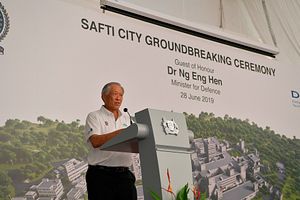Earlier this month, Singapore’s defense minister offered an update as to the status of an ongoing review on Singapore’s maritime security, which could result in some restructuring. The comments spotlighted the country’s ongoing response to the complex maritime environment that it faces.
As I have noted before, Singapore faces a range of challenges in its maritime domain, with the country having one of the world’s busiest ports and straddling major sea lanes, and the short distance between its shoreline and the international boundary putting pressures on the time and space it has to respond to seaborne challenges such as terrorism, smuggling, illegal immigration, and piracy through a range of actors, including the Singapore Navy, the Police Coast Guard, and the Maritime and Port Authority, as well as coordinating mechanisms such as the Singapore Maritime Crisis Center.
Among these has been the setting up of a Maritime Security Task Force (MSTF). The MSTF of the Singapore Navy, set up in 2009, works with law enforcement and maritime agencies to guard Singapore’s waters, including conducting daily patrols as well as boarding and escort operations in the Singapore Strait.
Last week, the MSTF was in the headlines with an update on ongoing changes by Defense Minister Ng Eng Hen. In a written reply to a parliamentary question, Ng said that there were ongoing plans to restructure the MSTF to deal with a range of challenges, including piracy at sea.
Specifically, Ng said that a review on the subject was expected to be completed within the next few months. And while he did not provide much more in terms of specifics, he suggested that extra measures may be useful given fluctuations in sea robbery and piracy incidents over the past few years, with 31 incidents occurring last year and 12 occurring in the last two months alone.
To be sure, changes in the MSTF will only be one part of Singapore’s wider response to managing maritime security challenges. For instance, as Ng himself pointed out, since recent incidents have been occurring outside of Singapore’s own territorial waters, it would also require increased cooperation and coordination with neighboring countries as well such as Malaysia and Indonesia, whether it be on a bilateral basis or through the use of subregional mechanisms such as the Malacca Straits Patrols (MSP), including through exercises, patrols, and monitoring.
Nonetheless, given its significance, the MSTF’s development will continue to be important to watch in the coming months as it takes shape, both in terms of its own sake as well as how it factors into Singapore’s broader response to maritime security challenges more generally and affects its domestic and foreign policy.

































